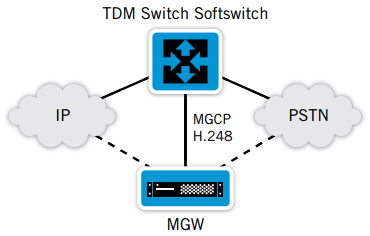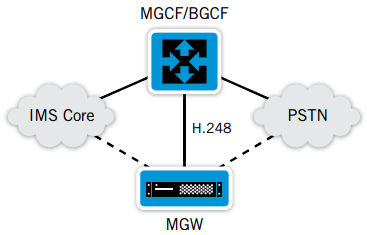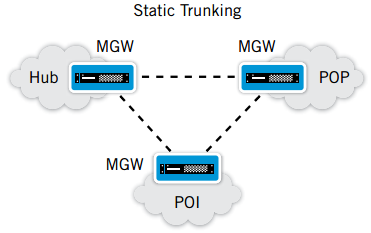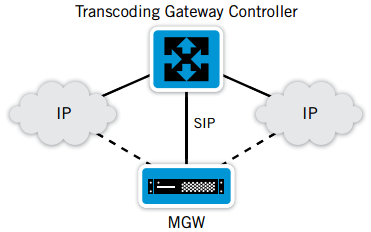Overview:
The Dialogic I-Gate 4000 Media Gateways (MGWs) are designed for Communications Service Providers (CSPs) seeking a competitive advantage by moving to an operationally efficient and service-centric Next Generation Network (NGN) or IMS architectures. I-Gate 4000 MGWs deliver fixed-line, toll-quality voice in a compact footprint for satisfying IP and TDM telephony requirements in both low- and medium-scale port densities.
I-Gate 4000 MGWs leverage state-of-the-art Digital Signal Processing (DSP) technology, and have set a benchmark for telephony voice quality while preserving end-to-end service transparency for voice, fax, modem, and video calls. And finally, they combine high-quality bandwidth optimization, reliability, and scalability with open standards-based interfaces, to provide OPEX and CAPEX savings opportunities in the most demanding mobile, IPX and fixed network applications.
I-Gate 4000 PRO and EDGE Media Gateways provide the latest capabilities to help you expand your services and lower your costs:
- Latest audio format support, like HD Voice, for generating revenue
- IP-to-IP transcoding
- Reduce bandwidth by up to 93% without compromising voice quality for inter I-Gate applications
- Open platform compatible with a wide variety of class 4 switching technologies
- Up to six 9s availability
I-Gate 4000 Media Gateways can help modernize your network and cost effectively cap or replace your end-of-life legacy media gateway technology with a reliable solution to help you get the most out of your existing infrastructure without compromising network availability or voice quality. I-Gate Media Gateways are an open, supported solution that service providers can use to replace their existing end-of-life gateways from vendors like Cisco.
I-Gate 4000 PRO and EDGE Media Gateways along with the Dialogic ControlSwitch System softswitch and BorderNet Session Border Controllers are part of Dialogic's comprehensive portfolio of IMS transformation solutions to help you take your network to the next level.
Unparalleled Optimization Delivers Cost Savings
Field-proven voice processing technology and advanced codec implementations, coupled with a rich set of bandwidth optimization and voice quality protection techniques, enable CSPs to realize bandwidth savings (up to 16:1) without compromising on voice quality.
Field-Proven in IMS and TDM Networks
Service providers around the globe have deployed I-Gate 4000 MGWs in networks spanning more than 100 countries for voice, fax, modem, video, and signaling traffic. I Gate 4000 MGWs enable carriers to bridge the gap between circuit-switched and next-generation Voice-over-IP (VoIP) and IMS/VoLTE networks by delivering exceptional voice quality over both TDM and IP networks.
Cost Effective, Bandwidth-Efficient and Reliable Signaling Transport
I-Gate 4000 MGWs are unmatched in their support for bandwidth-efficient and reliable transport of Common Channel Signaling (CCS) for SS7, PRI, and QSIG and Channel Associated Signaling (CAS), even under impaired network conditions. The highly efficient signal detection and processing techniques featured on I Gate 4000 MGWs provide unrivaled call completion rates with exceptional quality for voice, fax, modem, and video calls, allowing CSPs to reduce expenses while increasing the capture of billable minutes.
Open, Flexible Platform
I-Gate 4000 MGWs are built with “total openness” in mind. I-Gate 4000 MGWs are IMS- and NGN-ready and comply with industry standards/ protocols such as MGCP, H.248, SIP and SS7/SIGTRAN. They offer field-proven interoperability with wide array of other vendors’ softswitches allowing CSPs the flexibility to deploy and support a variety of network topologies that enable them to optimize signaling gateway placement and consolidate infrastructure footprint.
Deployments:
Support for Multiple Deployment Modes
I-Gate 4000 MGWs provide multiple deployment modes to support a variety of network architectures including NGN, IMS/VoLTE and wholesale voice. CSPs have the flexibility to deploy I-Gate 4000 MGW platforms in following modes to accommodate their service delivery and operational requirements:
- Softswitch-controlled mode
- IMS Media Gateway mode
- Standalone static trunking mode
- Transcoding gateway mode (RFC 4117)
 Softswitch-Controlled Mode
Softswitch-Controlled Mode
CSPs can deploy I Gate 4000 MGWs in multiple next-generation IP switching applications including:
- Domestic and international long-distance services
- Wireline or wireless network tandem switching
- Class 4 switch replacement, and
- PRI trunking
I-Gate 4000 MGWs support standard gateway control protocols like MGCP and H.248 to enable interoperability with a wide variety of different vendors’ switching platforms.
 IMS Media Gateway Mode
IMS Media Gateway Mode
Multimedia services are at the heart of IMS, with media interworking playing a key role in IMS deployments. I-Gate 4000 MGWs can help CSPs transition to an IMS network by acting as an IMS MGW. As the IMS MGW, an I-Gate 4000 MGW interconnects with an MGCF via H.248 for resource control and to provide services like:
- Managing circuit-switched bearer channels and packet-switched media streams
- Media transcoding and optimization
- Application of resources such as echo cancellation, CNG and VAD
 Standalone Static Trunking Mode
Standalone Static Trunking Mode
For CSPs carrying voice traffic over costly or bandwidth-limited transmission links, the static trunking feature of I-Gate MGWs is well suited to help them with:
- Substantial savings on bandwidth,
- Reduced equipment CAPEX and OPEX,
- More efficient utilization of deployed network resources, and
- New ways to improve competitiveness and increase profitability
In static trunking, the traffic transmitted between PSTN and/or MSC switches is compressed by an I Gate 4000 EDGE or I-Gate 4000 PRO MGW connected to one of the switches and decompressed at a remote I Gate 4000 EDGE or PRO MGW connected to the second switch. The compressed traffic can be carried over IP or TDM networks. Static trunking can be used for minimizing costs and optimizing traffic on international and domestic voice routes, inter-MSC links, between call centers, on connections from mobile and fixed networks to PSTN POIs, and on backup protection networks.
 Transcoding Gateway1 Mode
Transcoding Gateway1 Mode
CSPs can deploy the I-Gate 4000 PRO MGW as a high-density media transcoding platform (up to 62,400 call legs) for next generation IP networks. I-Gate 4000 PRO MGWs support scenarios requiring media interworking described in RFC 4117, “Transcoding Services Invocation in the Session Initiation Protocol (SIP) Using Third Party Call Control (3pcc).” Transcoding resources can be controlled via SIP for applications requiring an RFC 4117 compliant transcoding server to support third party call control (3pcc) when codec interworking is required between two SIP endpoints. The I-Gate 4000 PRO can work with the Dialogic ControlSwitch System, BorderNet SBCs, and IMS Application Servers or other compliant platforms to interwork media streams between.
1 Supported in I-Gate 4000 PRO release 3.8.6.x or later
Specifications:
| Technical Specifications for Both I-Gate 4000 EDGE Media Gateway and I-Gate 4000 PRO Media Gateway |
| Traffic Processing |
- Signal Detection and Classification (Voice, Fax, VBD, Video, DTMF, signaling)
- Silence Suppression (Voice Activity Detection and Comfort Noise Injection)
- Router-agnostic and bandwidth-efficient RTP Multiplexing mechanism
- Bandwidth-efficient signaling transmission mechanism (SS7, PRI, CAS)
- SRTP1 support to provide encryption, message authentication, integrity and replay protection to the RTP (and SRTCP for RTCP) sessions
|
| Voice Codecs |
- G.711 PCM @64 kbps A-law/µ-law
- G.729A (+B) CS-ACELP @8 kbps
- G.723.1 ACELP /MPMLQ @5.3, 6.3 kbps
- EFR @12.2 kbps
- AMR-WB2,3 all rates (6.6, 8.85, 12.65, 14.25, 15.85, 18.25, 19.85, 23.05, 23.85) kbps
- iLBC2,3 – iLBC20 and iLBC30
- OPUS (6, 8, 12) Kbps)
|
| Echo Cancellation |
- ITU G.168 and G.165 compliant
- Up to 128 msec echo tail length
- Dynamic EC enabling
|
| Fax |
- Group 3 fax calls
- V.27, V.29 and V.17 (up to 14.4 kbps)
- ITU T.38 fax relay or Passthrough mode
- V.34 fax (V.Fax) — Passthrough mode
|
| Voice Band Data (Modem) |
- V.22, V.23, V.32, V.34, V.90 and V.92 modems
- Passthrough mode
|
| Video |
Automatic detection and Clear channel mode transmission of H.324 video calls over bearer links |
| DTMF Handling |
- DTMF tones transfer according to RFC 2833
- MGCP/H.248 — DTMF package support
|
| Network Jitter Compensation |
Adaptive jitter buffer up to 300 msec |
| Clear Channel |
- 64 kbps (G.711), VAD OFF, EC OFF
- RFC 4040 Clear Mode
|
| Signaling |
- Compressed Common Channel Signaling, using SCTP to carry the signaling over IP
- ISDN support: ISDN-PRI though IUA SIGTRAN Protocol (RFC 3057)
|
| Embedded Cross-Connection |
- Any-DS0 to any-DS0
- Operator-configurable
|
| Security |
- Embedded firewall
- Access list
- IP Sec protocol (RFC 2401)
|
| Quality of Service |
- End-to-end compression quality protection
- QoS protection control mechanism — Operator-configurable threshold
- DiffServ (TOS field)
- ITU Q.50 Interface protocol
|
| TDM Interfaces |
- E1 complying with ITU G.703 and G.704
- T1 complying with ITU G.703 and G.704
|
| IP Protocols |
- IPv4
- RTP (RFC 3550)
- SRTP (RFC 3711)
- RTCP (RFC 3551)
- SNMPv2 (RFC 1907)
- FTP (RFC 959)
- SNTP (RFC 2030 v4)
- IP (RFC 791)
- UDP (RFC 768)
- Transcoding Services Invocation in the Session Initiation Protocol (RFC 4117)
|
| Typical bandwidth optimization –Gain/compression ratio (voice traffic) |
- G.729A - 12:1
- G.723.1 - 16:1
- GSM-AMR (12.2 kbps) - 8:1
- AMR-WB – depends on the rate
- iLBC - depends on the rate
- OPUS – depends on the rate
|
| Redundancy |
- Softswitch redundancy support
- Fan redundancy and turbo mode
|
| Reliability |
- 99.99995% (“six 9s”)
- Hot module swapping
- Hitless software upgrade
- Runtime configuration
|
| Power |
DC power input: -48 VDC / -60 VDC (nominal) |
| Internal Clock Accuracy |
4.7 ppm (Stratum 3) |
| Electro-Magnetic Compatibility |
- Europe:
- EN300 386 V1.3.2 (2003-05)
- Emission — EN55022
- Immunity — EN61000-4-2,3,4,5,6,11
- North America: FCC rules CFR 47 part 15
- Canada: ICES-003
- Japan: VCCI V-3/2001.04
- Australia/New Zealand: CISPR 22:04
|
| Product Safety |
- UL60950.1:2007 (US) (selected models)
- CAN/CSA-C22.2 No.60950-1-07 for Canada (selected models)
- CE EN60950-1:2006+All:2009
- CB-Safety: IEC 60950-1:2005 (selected models)
|
| Environmental Standards |
- ETSI — ETS 300 019
- Telcordia — GR-63 (selected sections)
- EU Directive 2002/95/EC (Restriction of Hazardous Substances — RoHS)
- EU Directive 2002/96/EC (Waste Electrical and Electronic Equipment — WEEE)
|
| Warranty |
1-Year |
| Additional Technical Specifications for Dialogic I-Gate 4000 EDGE Media Gateway |
| Operation Mode |
- Softswitch-controlled mode (MGCP v1.0, H.248/Megaco)
- IMS Media Gateway mode (H.248/Megaco) Standalone static trunking (without softswitch)
|
| Total Capacity |
Up to 496 simultaneous calls (any codec or combination of codecs) |
| Signaling |
- CAS-R1 (static trunking)
- CAS-R2 (static trunking)
- CAS-R2 (switched)
- CAS-R1.5 (switched)
- M3UA
|
| QoS Management |
- Multiple queues
- IP packet classification and marking
- Multiple congestion avoidance mechanisms
- Scheduling and shaping
- Policing
|
| Ethernet Interfaces |
- 100BaseT (Fast Ethernet)
- VLAN Tag — IEEE 802.1q
|
| Redundancy |
- Main module: 1:1 redundancy
- Power input: 1:1 redundancy
- Power supply: 1:1 redundancy
- IP link
- TDM Bearer
|
| Power |
- AC power input: 240 VAC / 100 VAC (nominal)
- Max. DC power consumption: 80 Watts
- Max. AC power consumption: 105 Watts
|
| Additional Technical Specifications for Dialogic I-Gate 4000 PRO Media Gateway |
| Operation Mode |
- Softswitch-controlled mode (MGCP v1.0, H.248/Megaco)
- IMS Media Gateway mode (H.248/Megaco)
- Standalone static trunking (without softswitch)
- Transcoding gateway (RFC 4117)
|
| Total Capacity |
- Up to 13,392 simultaneous G.729A and/or G.723.1 and/or EFR calls
- Up to 16,800 simultaneous G.711 calls
- Up to 62,400 IP transcoding sessions.(call legs)
|
| Signaling |
- CAS-R1 (DS3 or OC3, switched /MGCP package)
- CAS-R2 (CAS tunneling, static trunking)
- CAS-R1.5 (switched)
|
| DSP Pooling Functionality |
Ability to oversubscribe to maximize system utilization for low-Erlang deployments |
| Border Gateway |
- Support IETF MIDCON model
- IMS architecture-compliant
|
| Transcoding |
Voice, Fax, DTMF |
| Ethernet Interfaces |
- Gigabit Ethernet — optical and electrical interfaces
- 100BaseT
- VLAN Tag — IEEE 802.1q
|
| TDM Interfaces |
- DS3 complying with ANSI T1.102 and T1.107
- STM-1/OC3 (optical and electrical) complying with ITU G.703, G.707, G.813, G.825, G.783, G.957, and GR-253
|
| Redundancy |
- E1/DS1 TDM Interface cards: 1:N redundancy
- DS-3 TDM Interface cards: 1:N redundancy
- OC-3 / STM-1, SONET/SDH Interface card: 1:1 redundancy
- DSP cards: 1:N redundancy
- CPU, TDM-switch fabric, and Layer 2/3-switch fabric card: 1:1 redundancy
- Power Feed: 1:1 redundancy
- Clock: 1:1 redundancy
- 100BaseT and 1 Gigabit Ethernet ports: 1:1 link redundancy
- OC-3/STM-1 SONET/SDH: 1:1 link redundancy
|
| Power |
Max. DC power consumption: 795 Watts |
| Operating Temperature Range |
-5°C to 50°C |
| Dimensions |
- Height: 25 in. max (635 mm)
Width: 17.44 in. (444 mm)
Depth: 10.82 in. (274 mm)
Weight: 30 kg (fully populated)
|
1 SRTP is supported in DSPK-R2 and later model of DSPK cards. In media gateway mode, SRTP is supported only for MGCP MG (not MEGACO). SRTP can be used only for switch connections (not for static channels), or in STGW mode
2 AMR-WB & iLBC codec are supported ONLY for switch channels, not for static channels. As of the publication date of this document listed below, the earliest version of the Dialogic ControlSwitch System which supports AMR-WB & ILBS codecs is Release 5.9.2.
3 AMR-WB & iLBC codec are supported by I-Gate 4000 PRO and I-Gate 4000 EDGE models with DSPK-R2 only
![]()